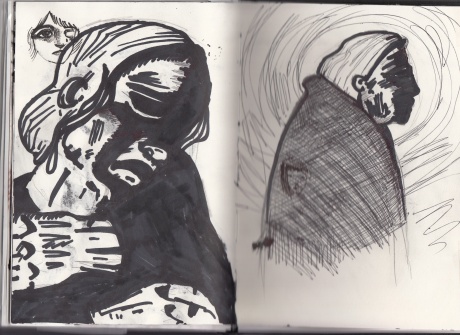
Two drawings inspired by two of Kollwitz’s works, the one on the left is a close up of her drawing of a mourning mother/widow, inspired by her own experiences. The one on the right is my version of one of her many self – portraits.
Kollwitz worked primarily in woodcut and lithography. I will be trying my hand at lithography in a couple of weeks. I’ve looked it up and its fairly straightforward just a lot of stages and a lot of washing plates. Woodcut on the other hand is simpler, you get a piece of wood and some shape implements and carve out an image. Which you then ink up and place paper on and repeat and add to as many times as you want to create a more details image. The expressionists favoured woodcut as its difficult and hard going to carve. But this made it more emotive and more expressive. It also worked well with harsh subject matters and really lets the image and its story shine through in simple black and white. Though Kollwitz trained as a painter, most of her work consisted of series of lithographs or woodcuts and pencil and charcoal studies. She also created sculptures. Though after her dismissal from the Prussian academy is lost her large sculpture studio. And was unable the carry on with that avenue of her work.
The Japanese also used woodblock printing. Though some printing techniques may seem tedious they were and are quicker and more reliable than replicating images by hand. Moveable type and printed image are essential to communication design. They make art accessible, affordable and efficient. Mass production of art and text is part of illustration. Prints can be mass produced but they can also be limited edition or single copies giving them infinite value.
Book used for help with this post – Martin, J. (1993) The Encyclopaedia of Printmaking Techniques. Quarto Publishing.
